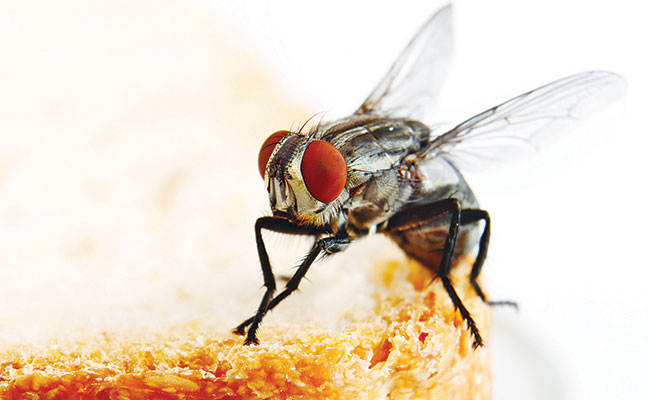PMP’s survey respondents look to the bright spots and the (labor-intensive) low lights in fly management.
Educated customers are happy customers — so happy they’ll give referrals. At least, that’s the consensus among many of the 116 respondents to this year’s flying insect management survey. Several of the pest management professionals (PMPs) who responded pointed out that if your technicians are knowledgeable on fly biology, behavior and management, and can communicate the information confidently to customers who must do their part pertaining to sanitation and prevention, half the battle is already won.
Another side benefit to fly management accounts? It gets your foot in the door for additional services. “Conditions that cause flies also cause rodent and bird problems,” points out Steven Fisher, owner of Fisher Pest Management, Veneta, Ore.
Opportunities exist for add-on services as well, says Edward Schwartz, ACE, president of Paladin Pest Control, Colorado Springs, Colo. “You can sell them biological cleaners (for between visits), install door sweeps for them and for commercial accounts, even offer sanitation evaluations as a safeguard to ensure they pass health inspections,” he adds.
For existing restaurant accounts in particular, says Doug Foster, president of Burt’s Termite & Pest Control, Columbus, Ind., upselling to fly service can improve your general pest management strategies with customers.
“It’s a great opportunity to work closely with the owner and manager,” he explains, noting that the crux of most fly management programs is improved sanitation, which will automatically reduce harborage for other pests. Plus, Foster says, when searching out fly breeding harborage sites, you “often get at the floor level and see other things going on in the restaurant that you don’t normally see.”
Inspect from top to bottom
Fly management inspections can be tedious, Foster warns, because you have to leave no stone (or other object) unturned.
“I learned to inspect everywhere after I was called to a cabin infested with green bottle flies,” he recalls. “I had assumed the problem was either the trash not being taken out often enough, or something was dead in the wall.
I even checked the crawlspace and found nothing.
“Two weeks later,” Foster continues, “the customer opens the chimney flue for a cozy fire, and two maggot-infested duck carcasses drop onto the hearth.” Had Foster thought to open and close the flue during his inspection, the unpleasant surprise might have been avoided.
Dan Scott, owner of The Bug Guy, Nixa, Mo., notes that thorough fly management inspections can also prevent hidden dangers. His team learned the hard way: “There were house flies in a restaurant, so we installed insect light traps next to the rear exterior door that leads into the kitchen. We didn’t know there was a big hose behind pullout storage shelves that they used to wash down the floors. One of the employees got the shelving caught on the hose and ended up breaking it off. Water soaked one of the traps, causing the light to short out and throw sparks.”
Scott says in many of his firm’s restaurant accounts, it can be merely a matter of closing exterior doors and relocating the trash can/dumpster area farther away from those doors.
What fly is this?
When PMPs discuss flying insects, the pests they refer to can run the gamut of house flies to fruit flies to biting flies, with several species in between. (For a key of how the industry generally defines flies, created with the assistance of Dr. Gerry Wegner, BCE-Emeritus, see bottom.)
“What takes the longest to learn is the right timeframe for different types of fly programs, and determining an effective program for each scenario,” says Frank Daigle, general pest manager of Banks Pest Control, Bakersfield, Calif. On the plus side, he notes, offering a solid fly management program can open doors to new categories of accounts, such as waste management facilities, dairy processing headquarters and medical institutions.
Andy Nieves, operations manager for BHB Pest Elimination, New York City, says taking your time to do the job right at a fly management account can be worth the extra steps.
“There was an account that kept calling us for flies. We would go there one week and treat breeding sites, show them, and then a week later conditions persisted,” he recalls. “We put together a daily treatment program, followed by a weekly, then bi-weekly and finally monthly treatment — with the occasional fly treatment in-between.
“We learned that educating customers as to why they have the problem, along with a well-thought-out plan and program, can lead to success,” Nieves concludes. “We also learned that people are willing to pay for quality service if they know you have a plan.”
Takeaway tips
“Document conducive conditions that need to be corrected by the customer, as well as all the structural repairs that need to be performed by the customer to exclude flies.”
— Dr. Gerry Wegner, BCE-Emeritus, entomology consultant, Vero Beach, Fla.
“Have customers clean up garbage and debris, including pet feces in the yard. Don’t let them keep their windows open without screens.”
— Lyle Townsend, president, Townsend Pest Control, Henderson, Nev.
“Do your work when the place is empty so you can work unimpeded. Don’t be afraid to get dirty.”
— Doug Foster, president of Burt’s Termite & Pest Control, Columbus, Ind.
“Pesticide label restrictions can change. Check the label whenever you re-purchase any product. This is paramount if you are controlling flies in food-processing and food-service operations.”
— Scott Armbrust, owner of Rid-A-Pest Exterminators, Littleton, Colo.
“Make sure clients don’t overwater plants or grass, and that they don’t accumulate grass clippings. Improper garbage containment is another big factor for fly control.” — Steven Fisher, owner of Fisher Pest Management, Veneta, Ore.
“Hang mops to dry, because mops left on the floor breed flies. Keep doors closed and keep trash away from the building. Create a 3-ft. vegetation-free zone around buildings.”
— Edward Schwartz, ACE, president of Paladin Pest Control, Colorado Springs, Colo.
You can reach Editor Heather Gooch at hgooch@northcoastmedia.net or 330-321-9754.






Leave A Comment